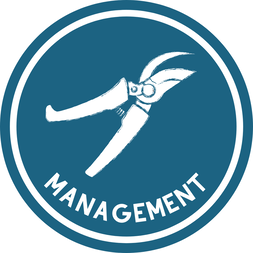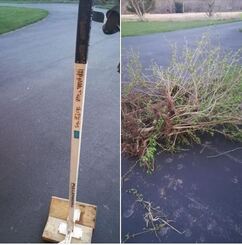Invasive ManagementInvasive species management is the key to keeping invasives at bay and encouraging native growth. Invasives may never be fully eradicated, but they can be managed to make minimal impacts on the environment, human health, and the economy. There are different types of management, each with their own pros and cons.
|
Types of Management
|
There are typically two main types of management: physical and chemical management.
Some invasives are classified as Noxious Weeds and must be removed according to the Destruction of Detrimental Plant Law. What Method to Use |
Invasive species survey HIP and the Hamilton County SWCD can offer invasive species assessments and help you develop a plan for effective invasive species control. Large parcels and woodlands are prioritized for this service. Contact HIP at hcinvasives@hamiltoncounty.in.gov |
Often the decision between physical and chemical treatment of invasives comes down to scale. For example a small bush honeysuckle may be easily removed by hand, but larger ones may need to be cut and treated. Or in terms of area, a small patch of purple wintercreeper in your landscaping may be removed by hand, but an acre may need to be treated with a foliar spray application.
Beyond the question of scale, removal methods for invasive species vary widely depending on their reproduction and ecology. Additionally, it takes maintenance to keep invasive species from recolonizing an area. Establishing native species after removal can help keep invasives at bay. The resources in this section will help you answer the key questions: What do I do? How do I do it? And what resources can I use to get the tools and information I need?
Beyond the question of scale, removal methods for invasive species vary widely depending on their reproduction and ecology. Additionally, it takes maintenance to keep invasive species from recolonizing an area. Establishing native species after removal can help keep invasives at bay. The resources in this section will help you answer the key questions: What do I do? How do I do it? And what resources can I use to get the tools and information I need?
Our friends at Southern Indiana Cooperative Invasives Management have created a landowners toolkit for invasive identification and removal. This collection of resources is a great place to start. These control and management guides are also great resources.
|
The SICIM calendar of control treatment calendar is a great way to visualize what time of year, what management style, and herbicide is best for different species.
A study on the potential carcinogenic effects (or lack there of) of glyphosate was published in 2021. You can read a summary of that study here. |
|
Information by Species
|
Asian bush honeysuckle
Canada thistle Multiflora rose Border privet Japanese knotweed Asian bittersweet White and Yellow Sweet-clover Poison hemlock Tree-of-heaven |
Callery pear
Garlic mustard Autumn olive Common teasle White mulberry Reed canarygrass Tall fescue Crown vetch Burning bush |
Wintercreeper
Vinca English ivy Burning bush Japanese honeysuckle Swallow-worts Japanese barberry Dame's rocket |
Report Invasives
Reporting invasives to the correct place is key in invasive species management.
Invasives along interstates: Include all information on form and species, if possible.
Invasives along interstates: Include all information on form and species, if possible.


